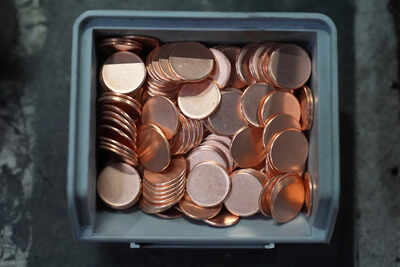End of an era: US penny bids goodbye after last coin pressed in Philadelphia; 238 years old currency finally retires after Trump’s order

After more than two centuries of jingling in pockets and cash drawers, the American penny has reached the end of its life. The final batch of one-cent coins was pressed this week at the US Mint in Philadelphia, an event overseen by US Treasurer Brandon Beach.Earlier in February, US President Donald Trump announced that he has asked the Mint to end penny production, saying the tiny coin had become too expensive to make. Each penny now costs nearly four cents to produce, more than its actual value.Beach confirmed that the last coins made will be auctioned off, while the final pennies to enter circulation were struck in June. Despite the halt, all existing pennies will remain legal tender.The penny, first issued in 1787, predates the Mint itself by six years. It outlived its half-penny sibling by 168 years and leaves behind the nickel, dime, quarter and the little-used half-dollar and dollar coins. Once able to buy “penny candy” or pay a parking meter, the coin now lives mostly in dusty jars or “take a penny, leave a penny” trays.
A chaotic farewell – No pennies left to pay
What should have been a quiet retirement has turned messy as retailers across the country are struggling to manage prices and payments without the one-cent coin.Some are rounding prices to the nearest nickel, often a cent or two higher, while others are asking customers to pay with pennies if they still have them. But state laws that require exact pricing are making things complicated.And while ending penny production should save money, the government might end up spending more by pressing extra nickels, which are even costlier to make.Mark Weller, executive director of Americans for Common Cents told CNN that the government’s ruling out of the penny has been “a bit chaotic.” “By the time we reach Christmas, the problems will be more pronounced with retailers not having pennies.”Weller noted that other nations, including Canada, Australia and Switzerland, handled similar transitions with clear guidance. “We had a social media post (by Trump) during Super Bowl Sunday, but no real plan for what retailers would have to do,” he said.Counting the changeOne of the first to act was Kwik Trip, a family-run convenience store chain in the Midwest. It decided to round down cash purchases in stores short on pennies.“There’s no way that we wanted to charge (customers) an extra 2 cents because we just didn’t think that was fair,” John McHugh, the company’s spokesperson told CNN. “I mean, it’s not their fault that there’s a penny shortage.”The move will cost Kwik Trip dearly, a couple of million dollars a year, McHugh said, with 20 million customers annually and nearly one in five paying in cash.Consumers will also feel a small pinch. A Federal Reserve Bank of Richmond study in July estimated that rounding to the nearest nickel could cost households about five cents a year, totalling $6 million nationwide.But not every state allows rounding. Delaware, Connecticut, Michigan and Oregon, along with major cities including New York, Philadelphia, Miami and Washington DC, still require exact change.The rules also clash with the federal SNAP food assistance programme, which must charge users the same as everyone else. Because SNAP payments are electronic and precise, rounding for cash customers could land stores in legal trouble.“Rounding down on all transactions presents several challenges beyond the loss of an average of 2 cents per transaction,” said Jeff Lenard, spokesperson for the National Association of Convenience Stores (NACS). “We desperately need legislation that allows rounding so retailers can make change for these customers.”NACS and several retail groups have already written to Congress asking for clear legislation to cover payments now that the penny is gone.
‘Time to go away’
The penny was among America’s first coins, designed before the Mint even existed. Benjamin Franklin is widely credited with creating the first version, known as the Fugio cent. The modern Lincoln penny arrived in 1909 to honour the 100th anniversary of Abraham Lincoln’s birth — the first American coin to carry a president’s face.Roughly 300 billion pennies are thought to be in circulation today, worth less than $9 for every American. Most, though, rarely change hands.Still, for some, the coin’s disappearance feels personal. Joe Ditler, a 74-year-old writer and historian from Colorado, keeps a cigar box full of pennies passed down from his grandfather.He remembers flattening them on train tracks and making souvenirs from them in amusement parks. “They bring back memories that have stayed with me all my life,” he said. “The penny has had a wonderful life. But it’s probably time for it to go away.”






